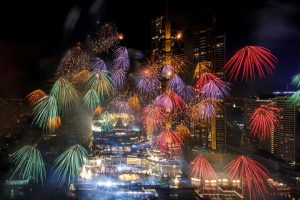Chao Phraya River
The conservation status of most of these in unclear (they are rated as data deficient by the IUCN), but Cryptophaea saukra is critically endangered and Caliphaea angka is endangered. The Chao Phraya basin is home to around 280 species of fish, including about 30 endemics. There are few areas of wetland protected as national parks, but these are mostly very small. By far the most diverse family is Cyprinidae with 108 species.
In addition, 4,000 metric tons of plastic flows down the river into the Gulf of Thailand every year. London: John Murray, Albemarle Street. Tamara Loos (1 December 2002). “Introduction to Five Years in Siam”. To counter this, Thailand’s Department of Marine and Coastal Resources (DMCR) signed an agreement with The Ocean Cleanup organization to deploy an Interceptor Original, one of the organization’s solar-powered, automated systems, in the river. 21. OCLC 5272849. Retrieved 8 February 2012. The Mae Nam Chao P’ia is a magnificent river. Lexico UK English Dictionary. Surveying and exploring in Siam (PDF).
Asian elephants, Javan rhinoceroses, and the much-hunted Schomburgk’s deer. Today there is a small area of this remaining in Khao Sam Roi Yot National Park, a relic of the original landscape. It is believed that the area would have consisted of freshwater swamps inland and salty mangroves on the coast and the river estuaries. Today we can only guess at the original habitat and wildlife by comparing it with neighbouring countries. The swamp would have been covered in Phragmites marsh grasses. As so much has been cleared or altered the potential for creating large protected areas to preserve original habitat no longer exists.
There are populations of threatened birds, including colonies of breeding water birds such as the world’s largest populations of the near-threatened Asian openbill (Anastomus oscitans), and other birds such as the wintering black kite (Milvus migrans). Endemic mammals that remain are the limestone rat (Niviventer hinpoon), Neill’s long-tailed giant rat (Leopoldamys neilli), and the near-endemic Thailand roundleaf bat (Hipposideros halophyllus). The Chao Phraya basin is home to about half a dozen endemic dragonflies and damselflies.
398-407 in: Hoanh, C.T. IUCN Red List of Threatened Species. IUCN Red List of Threatened Species. Tan, H.H. (2009). “Pangasius sanitwongsei”. Jenkins, A., Kullander, F.F. Vidthayanon, C. (2011). “Balantiocheilos ambusticauda”. Vidthayanon, C. (2011). “Yasuhikotakia sidthimunki”. IUCN Red List of Threatened Species. IUCN Red List of Threatened Species. Szuster, B.W. (editors). Tropical Deltas and Coastal Zones: Food Production, Communities and Environment at the Land-water Interface. IUCN Red List of Threatened Species. Vidthayanon, C.; Baird, I.; Hogan, Z. (2016). “Urogymnus polylepis”. Ng, H.H. (2011). “Platytropius siamensis”.
The mouth of Chao Phraya River. The Tha Chin River is the major distributary of the Chao Phraya River. 400 km (249 mi) north to south and 180 km (112 mi) wide. The expanse of the Chao Phraya and Tha Chin Rivers and their distributaries, starting at the point at which the distributaries diverge, together with the land amid the triangle formed by the outermost and innermost distributary, form the Chao Phraya delta. The many distributaries of the Chao Phraya delta are interconnected by canals that serve both for irrigation and for transportation. The original swamp forests have almost entirely been removed as the plain has been converted to rice paddies, other agriculture, and urban areas like Bangkok – bangkok.thaibounty.com – .


